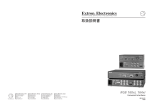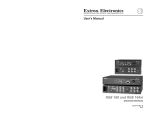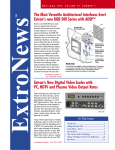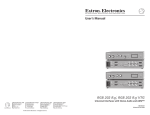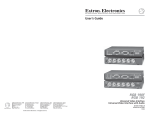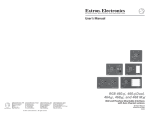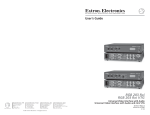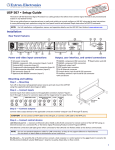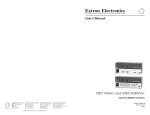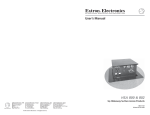Download Extron electronics Universal Interfaces RGB 134xi User`s manual
Transcript
User’s Manual RGB 130xi, 134xi, 160xi, 164xi Universal Interfaces www.extron.com Extron Electronics, USA Extron Electronics, Europe Extron Electronics, Asia Extron Electronics, Japan 1230 South Lewis Street Anaheim, CA 92805 USA 714.491.1500 Fax 714.491.1517 Beeldschermweg 6C 3821 AH Amersfoort The Netherlands +31.33.453.4040 Fax +31.33.453.4050 135 Joo Seng Road, #04-01 PM Industrial Building Singapore 368363 +65.6383.4400 Fax +65.6383.4664 Daisan DMJ Building 6F 3-9-1 Kudan Minami Chiyoda-ku, Tokyo 102-0074 Japan +81.3.3511.7655 Fax +81.3.3511.7656 © 2002 Extron Electronics. All rights reserved. 68-549-01 Printed in the USA Precautions Safety Instructions • English This symbol is intended to alert the user of important operating and maintenance (servicing) instructions in the literature provided with the equipment. This symbol is intended to alert the user of the presence of uninsulated dangerous voltage within the product's enclosure that may present a risk of electric shock. Caution Read Instructions • Read and understand all safety and operating instructions before using the equipment. Retain Instructions • The safety instructions should be kept for future reference. Follow Warnings • Follow all warnings and instructions marked on the equipment or in the user information. Avoid Attachments • Do not use tools or attachments that are not recommended by the equipment manufacturer because they may be hazardous. Consignes de Sécurité • Français Ce symbole sert à avertir l’utilisateur que la documentation fournie avec le matériel contient des instructions importantes concernant l’exploitation et la maintenance (réparation). Ce symbole sert à avertir l’utilisateur de la présence dans le boîtier de l’appareil de tensions dangereuses non isolées posant des risques d’électrocution. Attention Lire les instructions• Prendre connaissance de toutes les consignes de sécurité et d’exploitation avant d’utiliser le matériel. Conserver les instructions• Ranger les consignes de sécurité afin de pouvoir les consulter à l’avenir. Respecter les avertissements • Observer tous les avertissements et consignes marqués sur le matériel ou présentés dans la documentation utilisateur. Eviter les pièces de fixation • Ne pas utiliser de pièces de fixation ni d’outils non recommandés par le fabricant du matériel car cela risquerait de poser certains dangers. Sicherheitsanleitungen • Deutsch Dieses Symbol soll dem Benutzer in der im Lieferumfang enthaltenen Dokumentation besonders wichtige Hinweise zur Bedienung und Wartung (Instandhaltung) geben. Dieses Symbol soll den Benutzer darauf aufmerksam machen, daß im Inneren des Gehäuses dieses Produktes gefährliche Spannungen, die nicht isoliert sind und die einen elektrischen Schock verursachen können, herrschen. Achtung Lesen der Anleitungen • Bevor Sie das Gerät zum ersten Mal verwenden, sollten Sie alle Sicherheits-und Bedienungsanleitungen genau durchlesen und verstehen. Aufbewahren der Anleitungen • Die Hinweise zur elektrischen Sicherheit des Produktes sollten Sie aufbewahren, damit Sie im Bedarfsfall darauf zurückgreifen können. Befolgen der Warnhinweise • Befolgen Sie alle Warnhinweise und Anleitungen auf dem Gerät oder in der Benutzerdokumentation. Keine Zusatzgeräte • Verwenden Sie keine Werkzeuge oder Zusatzgeräte, die nicht ausdrücklich vom Hersteller empfohlen wurden, da diese eine Gefahrenquelle darstellen können. Instrucciones de seguridad • Español Este símbolo se utiliza para advertir al usuario sobre instrucciones importantes de operación y mantenimiento (o cambio de partes) que se desean destacar en el contenido de la documentación suministrada con los equipos. Este símbolo se utiliza para advertir al usuario sobre la presencia de elementos con voltaje peligroso sin protección aislante, que puedan encontrarse dentro de la caja o alojamiento del producto, y que puedan representar riesgo de electrocución. Precaucion Leer las instrucciones • Leer y analizar todas las instrucciones de operación y seguridad, antes de usar el equipo. Conservar las instrucciones • Conservar las instrucciones de seguridad para futura consulta. Obedecer las advertencias • Todas las advertencias e instrucciones marcadas en el equipo o en la documentación del usuario, deben ser obedecidas. Evitar el uso de accesorios • No usar herramientas o accesorios que no sean especificamente recomendados por el fabricante, ya que podrian implicar riesgos. FCC Class A Notice Warning Power sources • This equipment should be operated only from the power source indicated on the product. This equipment is intended to be used with a main power system with a grounded (neutral) conductor. The third (grounding) pin is a safety feature, do not attempt to bypass or disable it. Power disconnection • To remove power from the equipment safely, remove all power cords from the rear of the equipment, or the desktop power module (if detachable), or from the power source receptacle (wall plug). Power cord protection • Power cords should be routed so that they are not likely to be stepped on or pinched by items placed upon or against them. Servicing • Refer all servicing to qualified service personnel. There are no userserviceable parts inside. To prevent the risk of shock, do not attempt to service this equipment yourself because opening or removing covers may expose you to dangerous voltage or other hazards. Slots and openings • If the equipment has slots or holes in the enclosure, these are provided to prevent overheating of sensitive components inside. These openings must never be blocked by other objects. Lithium battery • There is a danger of explosion if battery is incorrectly replaced. Replace it only with the same or equivalent type recommended by the manufacturer. Dispose of used batteries according to the manufacturer's instructions. Note: This equipment has been tested and found to comply with the limits for a Class A digital device, pursuant to part 15 of the FCC Rules. These limits are designed to provide reasonable protection against harmful interference when the equipment is operated in a commercial environment. This equipment generates, uses and can radiate radio frequency energy and, if not installed and used in accordance with the instruction manual, may cause harmful interference to radio communications. Operation of this equipment in a residential area is likely to cause harmful interference, in which case the user will be required to correct the interference at his own expense. Note: This unit was tested with shielded cables on the peripheral devices. Shielded cables must be used with the unit to ensure compliance. Avertissement Alimentations• Ne faire fonctionner ce matériel qu’avec la source d’alimentation indiquée sur l’appareil. Ce matériel doit être utilisé avec une alimentation principale comportant un fil de terre (neutre). Le troisième contact (de mise à la terre) constitue un dispositif de sécurité : n’essayez pas de la contourner ni de la désactiver. Déconnexion de l’alimentation• Pour mettre le matériel hors tension sans danger, déconnectez tous les cordons d’alimentation de l’arrière de l’appareil ou du module d’alimentation de bureau (s’il est amovible) ou encore de la prise secteur. Protection du cordon d’alimentation • Acheminer les cordons d’alimentation de manière à ce que personne ne risque de marcher dessus et à ce qu’ils ne soient pas écrasés ou pincés par des objets. Réparation-maintenance • Faire exécuter toutes les interventions de réparationmaintenance par un technicien qualifié. Aucun des éléments internes ne peut être réparé par l’utilisateur. Afin d’éviter tout danger d’électrocution, l’utilisateur ne doit pas essayer de procéder lui-même à ces opérations car l’ouverture ou le retrait des couvercles risquent de l’exposer à de hautes tensions et autres dangers. Fentes et orifices • Si le boîtier de l’appareil comporte des fentes ou des orifices, ceux-ci servent à empêcher les composants internes sensibles de surchauffer. Ces ouvertures ne doivent jamais être bloquées par des objets. Lithium Batterie • Il a danger d'explosion s'll y a remplacment incorrect de la batterie. Remplacer uniquement avec une batterie du meme type ou d'un ype equivalent recommande par le constructeur. Mettre au reut les batteries usagees conformement aux instructions du fabricant. Vorsicht Stromquellen • Dieses Gerät sollte nur über die auf dem Produkt angegebene Stromquelle betrieben werden. Dieses Gerät wurde für eine Verwendung mit einer Hauptstromleitung mit einem geerdeten (neutralen) Leiter konzipiert. Der dritte Kontakt ist für einen Erdanschluß, und stellt eine Sicherheitsfunktion dar. Diese sollte nicht umgangen oder außer Betrieb gesetzt werden. Stromunterbrechung • Um das Gerät auf sichere Weise vom Netz zu trennen, sollten Sie alle Netzkabel aus der Rückseite des Gerätes, aus der externen Stomversorgung (falls dies möglich ist) oder aus der Wandsteckdose ziehen. Schutz des Netzkabels • Netzkabel sollten stets so verlegt werden, daß sie nicht im Weg liegen und niemand darauf treten kann oder Objekte darauf- oder unmittelbar dagegengestellt werden können. Wartung • Alle Wartungsmaßnahmen sollten nur von qualifiziertem Servicepersonal durchgeführt werden. Die internen Komponenten des Gerätes sind wartungsfrei. Zur Vermeidung eines elektrischen Schocks versuchen Sie in keinem Fall, dieses Gerät selbst öffnen, da beim Entfernen der Abdeckungen die Gefahr eines elektrischen Schlags und/oder andere Gefahren bestehen. Schlitze und Öffnungen • Wenn das Gerät Schlitze oder Löcher im Gehäuse aufweist, dienen diese zur Vermeidung einer Überhitzung der empfindlichen Teile im Inneren. Diese Öffnungen dürfen niemals von anderen Objekten blockiert werden. Litium-Batterie • Explosionsgefahr, falls die Batterie nicht richtig ersetzt wird. Ersetzen Sie verbrauchte Batterien nur durch den gleichen oder einen vergleichbaren Batterietyp, der auch vom Hersteller empfohlen wird. Entsorgen Sie verbrauchte Batterien bitte gemäß den Herstelleranweisungen. Advertencia Alimentación eléctrica • Este equipo debe conectarse únicamente a la fuente/tipo de alimentación eléctrica indicada en el mismo. La alimentación eléctrica de este equipo debe provenir de un sistema de distribución general con conductor neutro a tierra. La tercera pata (puesta a tierra) es una medida de seguridad, no puentearia ni eliminaria. Desconexión de alimentación eléctrica • Para desconectar con seguridad la acometida de alimentación eléctrica al equipo, desenchufar todos los cables de alimentación en el panel trasero del equipo, o desenchufar el módulo de alimentación (si fuera independiente), o desenchufar el cable del receptáculo de la pared. Protección del cables de alimentación • Los cables de alimentación eléctrica se deben instalar en lugares donde no sean pisados ni apretados por objetos que se puedan apoyar sobre ellos. Reparaciones/mantenimiento • Solicitar siempre los servicios técnicos de personal calificado. En el interior no hay partes a las que el usuario deba acceder. Para evitar riesgo de electrocución, no intentar personalmente la reparación/ mantenimiento de este equipo, ya que al abrir o extraer las tapas puede quedar expuesto a voltajes peligrosos u otros riesgos. Ranuras y aberturas • Si el equipo posee ranuras o orificios en su caja/alojamiento, es para evitar el sobrecalientamiento de componentes internos sensibles. Estas aberturas nunca se deben obstruir con otros objetos. Batería de litio • Existe riesgo de explosión si esta batería se coloca en la posición incorrecta. Cambiar esta batería únicamente con el mismo tipo (o su equivalente) recomendado por el fabricante. Desachar las baterías usadas siguiendo las instrucciones del fabricante. Extron’s Warranty Extron Electronics warrants this product against defects in materials and workmanship for a period of three years from the date of purchase. In the event of malfunction during the warranty period attributable directly to faulty workmanship and/or materials, Extron Electronics will, at its option, repair or replace said products or components, to whatever extent it shall deem necessary to restore said product to proper operating condition, provided that it is returned within the warranty period, with proof of purchase and description of malfunction to: USA, Canada, South America, and Central America: Extron Electronics 1230 South Lewis Street Anaheim, CA 92805, USA Asia: Extron Electronics, Asia 135 Joo Seng Road, #04-01 PM Industrial Bldg. Singapore 368363 Europe, Africa, and the Middle East: Extron Electronics, Europe Beeldschermweg 6C 3821 AH Amersfoort The Netherlands Japan: Extron Electronics, Japan Daisan DMJ Bldg. 6F, 3-9-1 Kudan Minami Chiyoda-ku, Tokyo 102-0074 Japan This Limited Warranty does not apply if the fault has been caused by misuse, improper handling care, electrical or mechanical abuse, abnormal operating conditions or non-Extron authorized modification to the product. If it has been determined that the product is defective, please call Extron and ask for an Applications Engineer at (714) 491-1500 (USA), 31.33.453.4040 (Europe), 65.6383.4400 (Asia), or 81.3.3511.7655 (Japan) to receive an RA# (Return Authorization number). This will begin the repair process as quickly as possible. Units must be returned insured, with shipping charges prepaid. If not insured, you assume the risk of loss or damage during shipment. Returned units must include the serial number and a description of the problem, as well as the name of the person to contact in case there are any questions. Extron Electronics makes no further warranties either expressed or implied with respect to the product and its quality, performance, merchantability, or fitness for any particular use. In no event will Extron Electronics be liable for direct, indirect, or consequential damages resulting from any defect in this product even if Extron Electronics has been advised of such damage. Please note that laws vary from state to state and country to country, and that some provisions of this warranty may not apply to you. Table of Contents Chapter 1 • Introduction ......................................................... 1-1 About this Manual ................................................................ 1-2 About the Interfaces ............................................................ 1-2 Features ...................................................................................... 1-2 Chapter 2 • Controls and Installation ........................... 2-1 Front Panel Features ............................................................ 2-2 Rear Panel Features .............................................................. 2-3 Installation ................................................................................ 2-4 Installation overview ............................................................. 2-4 Mounting the interface ......................................................... 2-5 Rack mounting (RGB 164xi only) ..................................... 2-5 Under desk mounting ...................................................... 2-6 Through desk mounting ................................................. 2-7 Cabling ................................................................................... 2-8 Setting the DIP switches ...................................................... 2-11 All models ....................................................................... 2-11 RGB 160xi and RGB 164xi only ....................................... 2-11 Setting internal jumpers ..................................................... 2-12 Appendix A • Specifications, Part Numbers, and Templates ................................................................................. A-1 Specifications ......................................................................... A-2 Accessories and Part Numbers ...................................... A-5 Mounting Templates ........................................................... A-6 All trademarks mentioned in this manual are the properties of their respective owners. 68-549-01 Rev. B Printed in the USA 03 02 xi xi xi xi • Table of Contents RGB 130xi xi, 134xi xi, 160xi xi, 164xi i Table of Contents, cont’d xi xi xi xi RGB 130xi xi, 134xi xi, 160xi xi, 164xi Page intentionally left blank 1 Chapter One Introduction About this Manual About the Interfaces Features ii xi xi xi xi • Table of Contents RGB 130xi xi, 134xi xi, 160xi xi, 164xi Introduction About this Manual This manual documents four universal interfaces: RGB 130xi, RGB 134xi, RGB 160xi, and RGB 164xi. Unless otherwise specified, any references to “the interface” shall refer to the features or operation of all four interfaces. About the Interfaces The RGB 130xi, 134xi, 160xi, and 164xi are universal interfaces with a video bandwidth of 300 MHz and a horizontal frequency range of 15-160 kHz. Features 2-color power/signal LED — When the interface is On, the power/signal LED lights amber. When the interface is On and a signal is present, the LED lights green. Gain/peak control— Increases signal voltages to compensate for signal degradation caused by long cable lengths. Stereo audio — Front panel audio input and a 3.5 mm captive screw output connector on the rear panel. Horizontal shift — The picture can be shifted horizontally. A min/max LED indicator lights red whenever the shifting reaches its lower or upper limits. Vertical shift (RGB 130xi and RGB 134xi only) — The picture can be shifted vertically. A min/max LED indicator lights red whenever the shifting reaches its lower or upper limits. ADSP™ (Advanced Digital Sync Processing) — Allows sync processing operations, such as horizontal centering, to occur without affecting the signal’s sync timing. This allows horizontal centering to be applied to signals that are output to digital display devices, such as LCD projectors, DLP (digital light processor) projectors, and plasma displays. Dual outputs (RGB 134xi and RGB 164xi only) — Provides two identical interfaced outputs. Buffered local monitor outputs (RGB 160xi and RGB 164xi only) — Provides a buffered local monitor output. Under/through desk mounting — The interfaces can be mounted either under or through a desk, or other suitable surface, using the optional mounting kit. Rack mounting (RGB 164xi only) — The RGB 164xi can be mounted on a standard 1U Universl rack shelf. 1-2 RGB 130xi, 134xi, 160xi, 164xi • Introduction xi xi xi xi RGB 130xi xi, 134xi xi, 160xi xi, 164xi 2 Chapter Two Controls and Installation Front Panel Features Rear Panel Features Installation Controls and Installation RGB 160xi and RGB 164xi — HD 15-pin female analog video input connector. Front Panel Features RGB 130 UNIVERSAL INTERFACE W/ADSP INPUTS ANALOG/ECL MBC 2 3 MBC power (RGB 130xi and RGB 134xi only) — 2.5 mm jack provides power for MBC buffer. 5 ID bit termination DIP switches (RGB 160xi and RGB 164xi only) — Provides proper ID bit termination on the local monitor output for a laptop computer that is not attached to a local monitor. 6 Buffered local monitor output (RGB 160xi and RGB 164xi only) — HD 15-pin female for output to a local monitor. 7 Horizontal shift control knob — Adjusts horizontal shifting of the remote output display device. MIN/MAX H. SHIFT V. SHIFT POWER 1 4 4 7 8 9 Figure 2-1 — RGB 130xi front panel RGB 134 UNIVERSAL INTERFACE W/ADSP INPUTS AUDIO ANALOG/ECL MBC MIN/MAX H. SHIFT V. SHIFT POWER 1 2 3 DDSP disables horizontal shift. 4 7 8 9 8 Vertical shift control knob — Adjusts vertical shifting of the remote output display device. 9 Min/max LED — Lights red whenever the lower or upper limits of the horizontal and vertical shift controls are reached. Figure 2-2 — RGB 134xi front panel RGB 160 ID PIN 4 ID PIN 11 INPUTS AUDIO ANALOG UNIVERSAL INTERFACE W/ADSP BUFFERED LOCAL MONITOR OUTPUT MIN/MAX H. SHIFT Rear Panel Features 100-240 1 2 3 5 6 7 0.5A MAX. GAIN/ PEAK 9 100% Figure 2-3 — RGB 160xi front panel COMPUTER NO MONITOR NO MONITOR AUDIO R G B H V S UNITY 50/60 Hz INPUTS SOG DDSP SERR 75 Ohm AUDIO 50% OUTPUT RGB 164xi 10 UNIVERSAL INTERFACE WITH ADSP™ MONITOR 11 12 13 15 Figure 2-5 — RGB 130xi rear panel ON MIN/MAX H. SHIFT 1 2 3 5 6 7 2-color power/signal LED — Lights amber to indicate power on only; lights green to indicate power on with video signal present. 2 Audio input jack — 3.5 mm stereo input. 3 Analog input connector — RGB 130xi and RGB 134xi — 9-pin D male analog/ECL video input connector. 2-2 xi xi xi xi • Controls and Installation RGB 130xi xi, 134xi xi, 160xi xi, 164xi AC power input — standard IEC AC power connector (100 240VAC, 50/60 Hz). 11 3-position gain/peak switch — unity; gain with 50% peaking; and gain with 100% peaking. Unity sets the output level equivalent to the input, with no added peaking. 9 Figure 2-4 — RGB 164xi front panel 1 10 If the signal cable between the interface and the display device is shorter than approximately 125 feet, and the Gain/Peak switch is set to a setting other than Unity, the image can be overcompensated. If the edges of the image seem to exceed their boundaries, or if thin lines and sharp edges look thick and fuzzy, try changing the Gain/ Peak switch setting. xi xi xi xi • Controls and Installation RGB 130xi xi, 134xi xi, 160xi xi, 164xi 2-3 Controls and Installation, cont’d 0.5A MAX. GAIN/ PEAK 100% SOG DDSP SERR 75 Ohm 100-240 R G B R G B H V S H V S 1 If desired, mount the interface to an equipment rack (RGB 164xi only) or to or through a desk or other suitable surface using Extron’s optional mounting kit. See Mounting the interface in the next section. 2 Turn off power to the computer and its monitor. Turn off power to the projector or display device. Disconnect the power cord from the interface. 3 Connect the computer to the Analog or Analog/ECL input connector on the front of the interface. If you are using an MBC interface with the RGB 130xi or 134xi, connect the MBC cable to the Analog/ECL connector and connect the MBC power cable to the MBC power jack. See the diagram in the Cabling section of this chapter. 4 For the RGB 160xi and RGB 164xi, if a local computer monitor is being used, connect the monitor to the Buffered Local Monitor Output connector. 5 For audio connections, see the Cabling and Connecting audio output sections in this chapter. 6 Connect the projector or other output display device(s) to the interface’s BNC output connectors, as described in the Cabling section in this chapter. 7 Set the interface’s DIP switches. See Setting the DIP switches at the end of this chapter. 8 Power on the computer, monitor, projector/display device, and the interface. The image should now display on screen. If it does not, double check steps 2 through 7 and make adjustments as needed. To adjust horizontal and vertical sync polarity and to set vertical sync pulse width, see Setting internal jumpers section at the end of this chapter. UNITY 50% 50/60 Hz 10 OUTPUT 1 11 OUTPUT 2 13 12 14 15 Figure 2-6 — RGB 134xi rear panel 0.5A MAX. GAIN/ PEAK 100% SOG DDSP SERR SPARE 100-240 R G B H V S UNITY 50/60 Hz 10 50% OUTPUT 11 13 12 15 Figure 2-7 — RGB 160xi rear panel 0.5 A MAX GAIN/ PEAK HIGH SOG DDSP SERR SPARE 100-240V R G B H V S AUDIO R G B H V S NONE L LOW 10 11 R INPUT 1 50-60Hz 13 12 OUTPUT 2 15 14 Figure 2-8 — RGB 164xi rear panel 12 DIP switches — 4 switches to control sync on green on output, Digital Display Sync Processing, serration pulses, and either 75Ohm (RGB 130xi and RGB 134xi) or spare (RGB 160xi and RGB 164xi) (see Setting the DIP switches in this chapter). DDSP disables horizontal shift. 14 BNC output — 6 BNC connectors to output RGsB, RGBS, and RGBHV. 15 Stereo audio output — 3.5 mm captive screw audio connector. 13 Installation Installation overview Except where noted, the installation procedures for the various interface models are the same. See Cabling in this chapter for additional information. 2-4 xi xi xi xi • Controls and Installation RGB 130xi xi, 134xi xi, 160xi xi, 164xi Mounting the interface The RGB 164xi can be mounted on a rack, all models can be mounted under or through a desk or other surface. Rack mounting (RGB 164xi only) Mount the RGB 164xi on an Extron 19" 1U Universal Rack Shelf (part #60-190-01) and in an equipment rack (figure 2-9) as follows: 1. Remove the feet from the bottom of the case if installed. 2. Mount the converter on the rack shelf, using two 4-40 x 1/8 screws in opposite (diagonal) corners. xi xi xi xi • Controls and Installation RGB 130xi xi, 134xi xi, 160xi xi, 164xi 2-5 Controls and Installation, cont’d AUD IO INPU ID PIN 4 ID PIN 11 T UNI VER SAL INTE H. SHIF T RFA RGB CE 160 xi W /AD SP RGB 160 Figure 2-10 — Attaching the under desk brackets Through desk mounting False Front Panel uses 2 front holes Mount the interface through a desk or table, as follows: 1. DI O INPU T ID PIN 4 ID PIN 11 AU Attach the mounting brackets to the interface using four machine screws and washers (supplied with the mounting kit), as indicated in figure 2-11. UN IVER SA L IN TE RF RGB AC E W 164 xi SH /ADS IFT P H. (2) 4-40 x 1/8" Screws Use 2 Mounting Holes on Opposite Corners Figure 2-9 — Rack mounting the RGB 164xi AUD Install a blank panel (included in the rack kit) or another 1U half-rack unit on the unused side of the rack. IO INPU T ID ID PIN 4 PIN 11 H. SHIF T UNIV ERS AL INTE 164 RGB W /ADS CE RFA xi P 3. Under desk mounting Mount the interface under a desk or in a podium as follows: 1. 2-6 Attach the mounting brackets to the interface using six machine screws supplied with the mounting kit (figure 2-10). RGB 164 Figure 2-11 — Attaching the through desk brackets 2. Using the to-scale template at the back of this manual to guide you, mark the four screw holes on the underside of the surface to which you are mounting the interface. Use the under desk mounting template. 2. Using the to-scale template at the back of this manual to guide you, mark the four screw holes on the underside of the surface to which you are mounting the interface. Use the through desk mounting template to cut the hole. 3. Drill four pilot holes, each 3/32” in diameter by 1/4” deep, where marked. 3. Drill four pilot holes, each 3/32” in diameter by 1/4” deep, where marked. 4. Using the four wood screws provided, attach the brackets under the mounting surface. 4. Using the four wood screws provided, attach the brackets to the mounting surface. xi xi xi xi • Controls and Installation RGB 130xi xi, 134xi xi, 160xi xi, 164xi xi xi xi xi • Controls and Installation RGB 130xi xi, 134xi xi, 160xi xi, 164xi 2-7 Controls and Installation, cont’d Cabling Each interface can connect to the computer or workstation’s local monitor, either directly or using an MBC cable, and to a projector or other display device. Rear Figure 2-12, and figure 2-14, figure 2-15, and figure 2-16, on the next two pages, show how to connect each of the interfaces. Front AU DI O INPU T MBC PO W ER H. SH IFT UN IVER SA L IN TE RF RGB AC E W 134 xi SH /ADS IFT P MIN/ MA X Projector SOG OUT DDSP SERR SPARE H. A 0.5 0V -24 100 Front AU DI O INPU T MBC UN ER H. SH IVER SA IFT H. SH IFT L IN TE A 0.5 0V -24 100 MBC Buffer or MBC/LBC Cable L/ VE LE AK PE 50% V 0.8 Hz Output 1 Extron RGB 134xi Interface UT TP OU Audio Power ITY UN % V 100 0.9 60 50/ Output 2 % V 100 0.9 60 50/ Rear RF RGB AC E W 130 xi /ADS P MIN/ MA X SOG OUT DDSP SERR SPARE PO W L/ VE LE AK PE 50% V 0.8 ITY UN MBC Buffer or MBC/LBC Cable UT TP OU Hz Extron RGB 130xi or Interface Monitor SUN or SGI Computer Audio Power Figure 2-14 — RGB 134xi installation or Front AU DI O INPU T UN H. 1. Connect the computer to the interface’s Analog/ECL (RGB 130xi and RGB 134xi) or Analog connector (RGB 160xi and RGB 164xi). IVER SH SA IFT L IN TE Rear RF RGB AC E W 150 xi /ADS P MIN/ MA X A 0.5 0V -24 100 UT TP OU ITY UN % V 100 0.9 60 50/ Extron does not guarantee the performance of the interface if a low quality input cable is used. 2. L/ VE LE AK PE 50% V 0.8 SOG OUT DDSP SERR SPARE Projector Figure 2-12 — RGB 130xi installation ID PIN 4 ID PIN 11 Monitor SUN or SGI Computer Hz Extron RGB 160xi Connect the unbalanced stereo audio sources (computer or other devices such as a CD player) to the front panel Audio Input jack. Interface Audio Power Wire the audio jack as shown in figure 2-13. Tip (Left) or Sleeve (Gnd) PC Computer Monitor Projector Figure 2-15 — RGB 160xi installation Ring (Right) Tip (Left) Sleeve (Gnd) Figure 2-13 — Audio input connection wiring 2-8 xi xi xi xi • Controls and Installation RGB 130xi xi, 134xi xi, 160xi xi, 164xi xi xi xi xi • Controls and Installation RGB 130xi xi, 134xi xi, 160xi xi, 164xi 2-9 Controls and Installation, cont’d Tip See warning Sleeve(s) Tip See warning Unbalanced Output Rear AU DI O UN IVER SA L IN TE RF RGB AC E W 164 xi SH /ADS IFT P H. Connect the sleeve(s) to ground (GND). Connecting the sleeve(s) to a negative (-) terminal will damage audio output circuits. Projector 0V -24 100 L/ VE LE AK PE 50% V 0.8 SOG OUT DDSP SERR SPARE UT A 0.5 TP OU Output 2 ITY UN % V 100 0.9 60 50/ Hz Extron RGB 164xi Setting the DIP switches Output 1 DIP switches on the rear panel of the RGB 130xi, and RGB 134xi, and on the front and rear panels of the RGB 160xi and RGB 164xi, are used to configure the interface. The switches can be either the rocking type or the sliding type. Interface Audio Power or PC 1 2 3 4 1 2 3 4 To set the rocking-type DIP switches, use a tweeker or small screwdriver to depress the appropriate end of each switch. To set the sliding-type DIP switches, use a tweeker or small screwdriver to slide the switch to the on/closed or off/ open position. Monitor Figure 2-16 — RGB 164xi installation R G B H V S R G B H V S R G B H V S 4. RGBHV – If both the H & V cables are connected, the interface outputs separate horizontal and vertical sync signals. RGBS – If the S (composite sync) cable is connected, the interface outputs composite sync. RGsB – If coax cables are connected and terminated (75 ohms) to the red, green, and blue channels only, and the SOG OUT switch is set to on (see Setting the DIP switches in this chapter), the interface outputs sync on green. Before connecting audio, determine whether your audio system is unbalanced or balanced. Connect an audio device, such as powered speakers, to the rear panel stereo audio output connector for balanced or unbalanced audio output. Following the wiring guide (figure 2-17), insert the wires into the appropriate openings in the captive screw connector. Tighten the screws on top to fasten the wires, then insert the wired audio connector into the audio output connector on the interface rear panel. Wiring the audio incorrectly can damage the audio output circuits. 2-10 xi xi xi xi • Controls and Installation RGB 130xi xi, 134xi xi, 160xi xi, 164xi All models The RGB 130xi, RGB 134xi, RGB 160xi, and RGB 164xi have four DIP switches on the rear panel to control: SOG DDSP SERR 75 Ohm Use BNC cables to connect the interface to a projector or other display device(s). 3. Balanced Output Figure 2-17 — Captive screw connector wiring for audio output INPU T ID PIN 4 ID PIN 11 Front Tip Ring Sleeve (s) Tip Ring • Sync on green output • Digital display sync processing • Serration pulses • 75-ohm input termination (RGB 130xi and RGB 134xi only, spare on RGB 160xi and RGB 160xi) SOG (sync on green output) On — If this switch is set to On, the interface outputs a composite sync signal on top of the green video signal via the G output connector (RGsB). Off — If the SOG feature is set to Off, output is RGBS or RGBHV, depending on how the interface and projector are cabled. DDSP™ (digital display sync processing) On — If this switch is set to On, the interface does not perform sync processing. This may be necessary for digital display devices, such as LCD (liquid crystal display), DLP (digital light processor) and plasma displays. xi xi xi xi • Controls and Installation RGB 130xi xi, 134xi xi, 160xi xi, 164xi 2-11 Controls and Installation, cont’d Off — If this switch is set to Off, the interface performs sync processing operations, such as horizontal shift, using Extron’s ADSP™. Turning on the DDSP feature disables the horizontal shift control and the vertical shift control. SERR (serration pulses) Follow these steps to change the jumper settings. The RGB 134xi is shown for illustration, but the steps apply to all interfaces. 1. Remove power from the interface by disconnecting the AC power cord from the unit. 2. Open the cover of the interface (the top half of the enclosure) (figure 2-18). Remove the screws from the enclosure, and lift the cover straight up. Many display devices, such as LCD and DLP projectors and plasma displays, must not have serration pulses present in the sync signal in order to display images properly. Flagging or bending at the top of the video image is a sign that the serration pulses should not be present. Do not touch any switches or electronic components inside the interface. Doing so could damage the interface. On — When this switch is set On, serration pulses are present with sync signal output. Slide cover back slightly, lift straight up. Off — When this switch is set Off, serration pulses are not present with sync signal output. 75 Ohm (local monitor video input termination) On — Set this switch on for 75-ohm input termination. AU DI O INPU T MB PO W C UN IVER ER H. SA SH IFT H. ID PIN 4 ID PIN 11 Off — Set this switch off for high impedance input termination. RGB 160xi and RGB 164xi only The RGB 160xi and RGB 164xi have two pin termination DIP switches to provide proper ID bit termination for a laptop computer that is not attached to a local monitor. ID PIN 4 & ID PIN 11 On — Set both pins to On if you are using the RGB 160xi or RGB 164xi interface with a laptop computer that is not connected to a local monitor. The jumpers inside the interfaces are set at the factory for optimal use by most systems. However, you can change a jumper setting to meet the needs of a particular system. Changes to internal jumper settings must be performed by authorized service personnel only. The user-configurable, internal jumpers control the following functions: • Horizontal and vertical sync polarity IFT L IN TE RF RGB AC E W 134 xi /ADS P MIN/ MA X Remove (6) Screws Figure 2-18 — Opening the interface cover 3. Note the positions of jumpers J20 and J40 before changing jumper settings. Figure 2-19 shows the locations of the J20 and J40 jumpers and the two possible setting combinations for 3-pin jumpers. 4. Configure the jumpers as defined below. To configure the jumpers, use pliers to pull the jumper shunt off the pins, then place the jumper on the appropriate pins (figure 2-20). Off — Set both pins to Off if you are connecting a local monitor to the interface. Setting internal jumpers SH The jumpers perform the following functions: J20: Sync polarity jumper — This jumper adjusts the output sync polarity. Horizontal (H) and vertical (V) sync output can either follow input sync polarity, or be forced to negative. 1 Follow Negative • If the jumper is placed on pins 1 and 2, output H and V sync polarities is forced to negative. • If the jumper is placed on pins 2 and 3, output sync polarity follows input sync polarity; the output sync signal’s polarity is the same as the input polarity. This is the default setting. • Vertical sync pulse width 2-12 xi xi xi xi • Controls and Installation RGB 130xi xi, 134xi xi, 160xi xi, 164xi xi xi xi xi • Controls and Installation RGB 130xi xi, 134xi xi, 160xi xi, 164xi 2-13 Controls and Installation, cont’d xi xi xi xi RGB 130xi xi, 134xi xi, 160xi xi, 164xi Pin 1 to Pin 2 Pin 2 to Pin 3 Rear 1 J19 1 J20 J20: Sync polarity jumper 1 J40 J40: Vertical sync width jumper Power Supply A Appendix A Front Figure 2-19 — Circuit board jumper locations Figure 2-20 — Changing jumper settings J40: Vertical sync width jumper — This jumper adjusts the vertical sync pulse width. Some digital display devices Wide have very specific requirements for incoming sync pulse Short width. If no picture displays, the picture cuts in and out, 1 or the picture is scrambled, try adjusting the vertical sync pulse width or switching from ADSP™ to DDSP™. 5. 2-14 • If the jumper is placed on pins 1 and 2, the output vertical sync pulse is short (narrow). • If the jumper is placed on pins 2 and 3, the output vertical sync pulse is wide. This is the default setting. Replace and fasten the enclosure cover, reversing step 2. xi xi xi xi • Controls and Installation RGB 130xi xi, 134xi xi, 160xi xi, 164xi Specifications, Part Numbers, and Templates Specifications Accessories and Part Numbers Mounting Templates Specifications, Part Numbers, and Templates Specifications Sync Video Gain ............................................... Unity, (0.725V p-p) 50% peaking, (0.75V p-p) 100% peaking Bandwidth .................................... 300 MHz (-3dB) Video input Number/signal type ................... 1 analog RGBHV, RGBS, RGsB, RsGsBs Connectors .................................... RGB 130xi, RGB 134xi ............... 1 9-pin D male RGB 160xi, RGB 164xi ............. 1 15-pin HD female Minimum/maximum levels ...... Analog ....... 0.3V to 1.5V p-p with no offset at unity gain Impedance .................................... RGB 130xi, RGB 134xi ............. 75 ohms or Hi Z, switchable (set to 75 ohms if no local monitor is connected) RGB 160xi, RGB 164xi ............. 75 ohms Horizontal frequency .................. Autoscan 15 kHz to 130 kHz Vertical frequency ....................... Autoscan 30 Hz to 120 Hz Return loss .................................... -30dB @ 5 MHz Maximum DC offset .................... 4.0V Video output Number/signal type ................... RGB 130xi, RGB 160xi ............. 1 analog RGBHV, RGBS, RGsB RGB 134xi, RGB 164xi ............. 2 analog RGBHV, RGBS, RGsB Connectors .................................... RGB 130xi, RGB 160xi ............... 6 BNC female RGB 134xi, RGB 164xi ............. 2 x 6 BNC female RGB 160xi, RGB 164xi ............. 1 15-pin HD female local monitor buffered output Minimum/maximum levels ...... Analog ....... 0.7V to 0.75V p-p with 0.70V p-p input Impedance .................................... 75 ohms A-2 Return loss .................................... -30dB @ 5 MHz xi xi xi xi • Specifications, Part Numbers, RGB 130xi xi, 134xi xi, 160xi xi, 164xi and Templates Input type ..................................... RGBHV TTL (±), RGBS TTL (±), RGsB 0.3V (-), RsGsBs 1.3V (-) Output type .................................. RGBHV (±), RGBS(±), RGsB (-) Input level ..................................... 2V to 5.5V p-p with ±0.2VDC offset (max.) Output level .................................. 4V to 5V p-p Input impedance .......................... 510 kohms Output impedance ...................... 75 ohms Max. propagation delay .............. 48 nS Max. rise/fall time ....................... 3.5 nS Polarity .......................................... RGBHV ...................... when RGBHV is input, polarity follows input; otherwise negative RGBS, RGsB .............. negative Audio Gain ............................................... Unbalanced 0dB, balanced +6dB Frequency response ..................... 20 Hz to 20 kHz, ±0.05dB THD + Noise ................................ 0.03% @ 1 kHz, 0.3% @ 20 kHz at rated maximum output drive S/N ................................................ >90dB, at the rated maximum output (14dBu), balanced Stereo channel separation .......... >95dB @ 1 kHz to 20 kHz Audio input Number/signal type ................... 1 PC level stereo, unbalanced Connectors .................................... 1 3.5 mm stereo jack, 2 channel; tip (L), ring (R), sleeve (ground) Impedance .................................... >10 kohms, DC coupled Maximum level ............................ +8.5dBu,(unbalanced) at stated %THD+N Audio output Number/signal type ................... Connectors .................................... Impedance .................................... Gain error ...................................... Maximum level (600 ohm) ......... 1 stereo (2 channel), balanced/unbalanced 1 3.5 mm captive screw connector, 5 pole 50 ohms unbalanced, 100 ohms balanced ±0.1dB channel to channel >+14dBm, balanced at stated %THD+N xi xi xi xi • Specifications, Part Numbers, RGB 130xi xi, 134xi xi, 160xi xi, 164xi and Templates A-3 Specifications, Part Numbers, Templates, cont’d General Accessories and Part Numbers Power ............................................. 100VAC to 240VAC, 50/60 Hz, 15 watts, internal, auto-switchable MBC power jack ........................... 9.0VDC, 150 mA Temperature/humidity .............. Storage -40° to +158°F (-40° to +70°C) / 10% to 90%, non-condensing Operating +32° to +104°F (0° to +40°C) / 10% to 90%, non-condensing Rack mount ................................... RGB 130xi, RGB 134xi, RGB 160xi .......................... No RGB 164xi .......................... Yes, with optional rack shelf, part #60-190-01 Furniture mount .......................... Yes, with optional kits, #70-077-01 and #70-077-02 Enclosure type .............................. Metal Enclosure dimensions RGB 130xi, RGB 160xi, .... 1.75" H x 6.4" W x 6.0" D 4.4 cm H x 16.3 cm W x 15.2 cm D (Depth excludes connectors.) RGB 134xi, RGB 164xi ...... 1.75" H x 8.75" W x 6.0" D 4.4 cm H x 22.2 cm W x 15.2 cm D (Depth excludes connectors.) Product weight ............................. RGB 130xi ................................. 1.3 lbs (0.6 kg) RGB 134xi, RGB 164xi ............ 1.7 lbs (0.8 kg) RGB 160xi ................................. 1.4 lbs (0.6 kg) Shipping weight ........................... RGB 130xi, RGB 160xi 3 lbs (1.4 kg) RGB 134xi, RGB 164xi ............ 4 lbs (1.8 kg) Vibration ....................................... ISTA/NSTA 1A in carton (International Safe Transit Association) Listings .......................................... UL Compliances ................................. CE, FCC Class A MTBF ............................................. 30,000 hours Warranty ....................................... 3 years parts and labor Specifications are subject to change without notice. A-4 xi xi xi xi • Specifications, Part Numbers, RGB 130xi xi, 134xi xi, 160xi xi, 164xi and Templates Universal Interfaces RGB 130xi 60-290-01 RGB 134xi 60-291-01 RGB 160xi 60-378-01 RGB 164xi 60-485-01 Mounting Kits 1U rack shelf (grey) 60-190-01 Under desk mounting kit 70-077-01 Through desk mounting kit 70-077-02 xi Monitor breakout cables: RGB 130xi xi/RGB 134xi xi MBC VGA/XGA HR 26-162-01 MBC Mac/Quadra 26-018-01 MBC SUN Sparc HR 26-424-01 MBC SGI/13W3 HR 26-425-01 Laptop breakout cables Laptop breakout cables are available in 3’, 6’, and 12’ lengths with or without audio. Contact Extron for the specific cable for your application. Cables LBC VGA HR 6’ 26-224-01 LBC Mac HR 6’ 26-363-01 LBC SUN HR 6’ (61 kHz) 26-413-01 LBC SUN HR 6’ (71 kHz) 26-413-02 LBC SUN HR 6’ (81 kHz) 26-413-03 LBC VGA HR 6’ A 26-441-02 LBC Mac HR 6’ A 26-442-02 LBC SUN HR 6’ A (61 kHz) 26-443-02 LBC SUN HR 6’ A (71 kHz) 26-444-02 LBC SUN HR 6’ A (81 kHz) 26-445-02 xi xi RGB 130xi xi, 134xi xi, 160xxi, 164xxi • Specifications, Part Numbers, and Templates A-5 Specifications, Part Numbers, Templates, cont’d Signal input cable kits for RGB 160xi, RGB 164xi VGA M6’ MHR 26-238-15 VGA M3’ MHRA 26-490-01 VGA M6’ MHRA 26-490-02 VGA M12’ MHRA 26-490-03 Mac Adapter kit with Audio 70-156-01 13W3 Adapter cable kit with Audio 70-157-01 BNC cables BNC-5 3’ HR 26-260-15 BNC-5 6’ HR 26-260-01 BNC-5 12’ HR 26-260-02 BNC-5 25’ HR 26-260-03 BNC-5 50’ HR 26-260-04 BNC-5 75’ HR 26-260-16 BNC-5 100’ HR 26-260-05 BNC-5 3’ HRP 26-378-01 BNC-5 6’ HRP 26-378-02 BNC-5 12’ HRP 26-378-03 BNC-5 25’ HRP 26-378-04 BNC-5 50’ HRP 26-378-05 BNC-5 75’ HRP 26-378-06 BNC-5 100’ HRP 26-378-07 Miscellaneous 3.5mm captive screw connector (five pole) 10-319-10 14 Conductor Install bulk, 500’ 22-120-02 14 Conductor Install bulk, 1000’ 22-120-03 17 Conductor Install plenum bulk, 500’ 22-111-03 17 Conductor Install plenum bulk, 1000’ 22-111-04 Mounting Templates A-6 xi xi xi xi • Specifications, Part Numbers, RGB 130xi xi, 134xi xi, 160xi xi, 164xi and Templates xi xi RGB 130xi xi, 134xi xi, 160xxi, 164xxi • Specifications, Part Numbers, and Templates A-7 Specifications, Part Numbers, Templates, cont’d RGB 134xi and RGB 164xi Under-Desk Mounting Bracket Dimensions A-8 xi xi xi xi • Specifications, Part Numbers, RGB 130xi xi, 134xi xi, 160xi xi, 164xi and Templates xi xi RGB 130xi xi, 134xi xi, 160xxi, 164xxi • Specifications, Part Numbers, and Templates A-9 Specifications, Part Numbers, Templates, cont’d RGB 134 and RGB 164 Through Desk Mounting Bracket Dimensions A-10 xi xi xi xi • Specifications, Part Numbers, RGB 130xi xi, 134xi xi, 160xi xi, 164xi and Templates


















